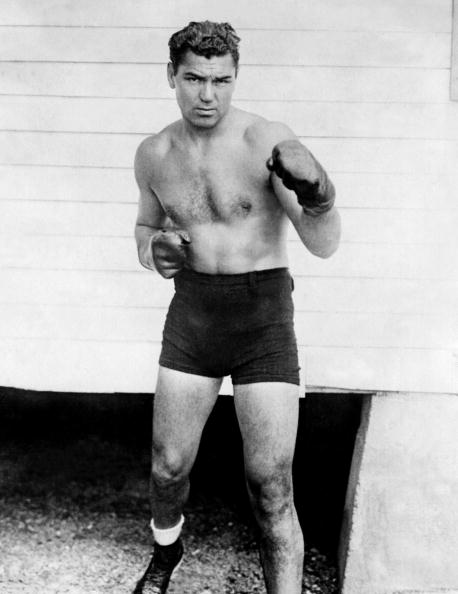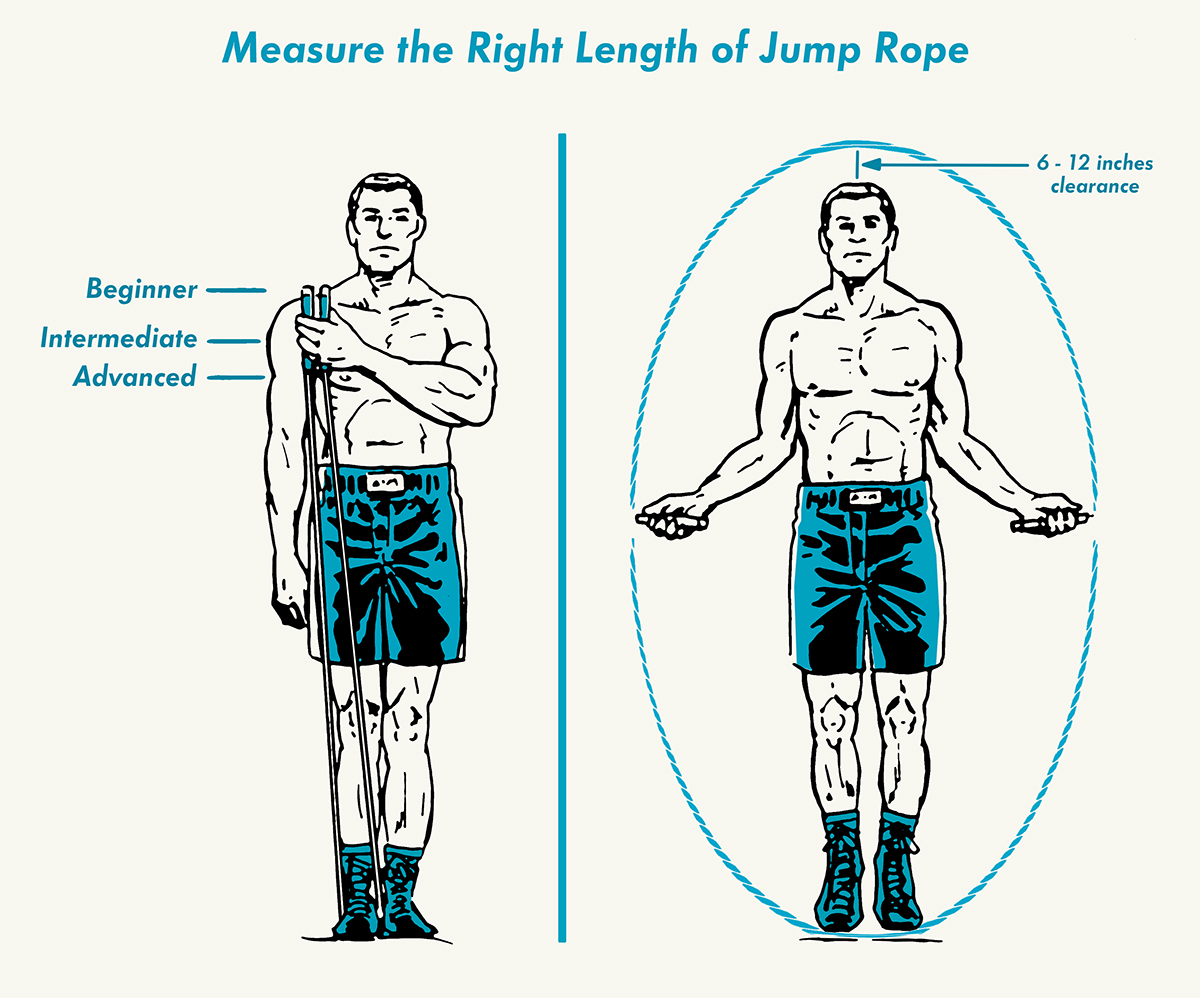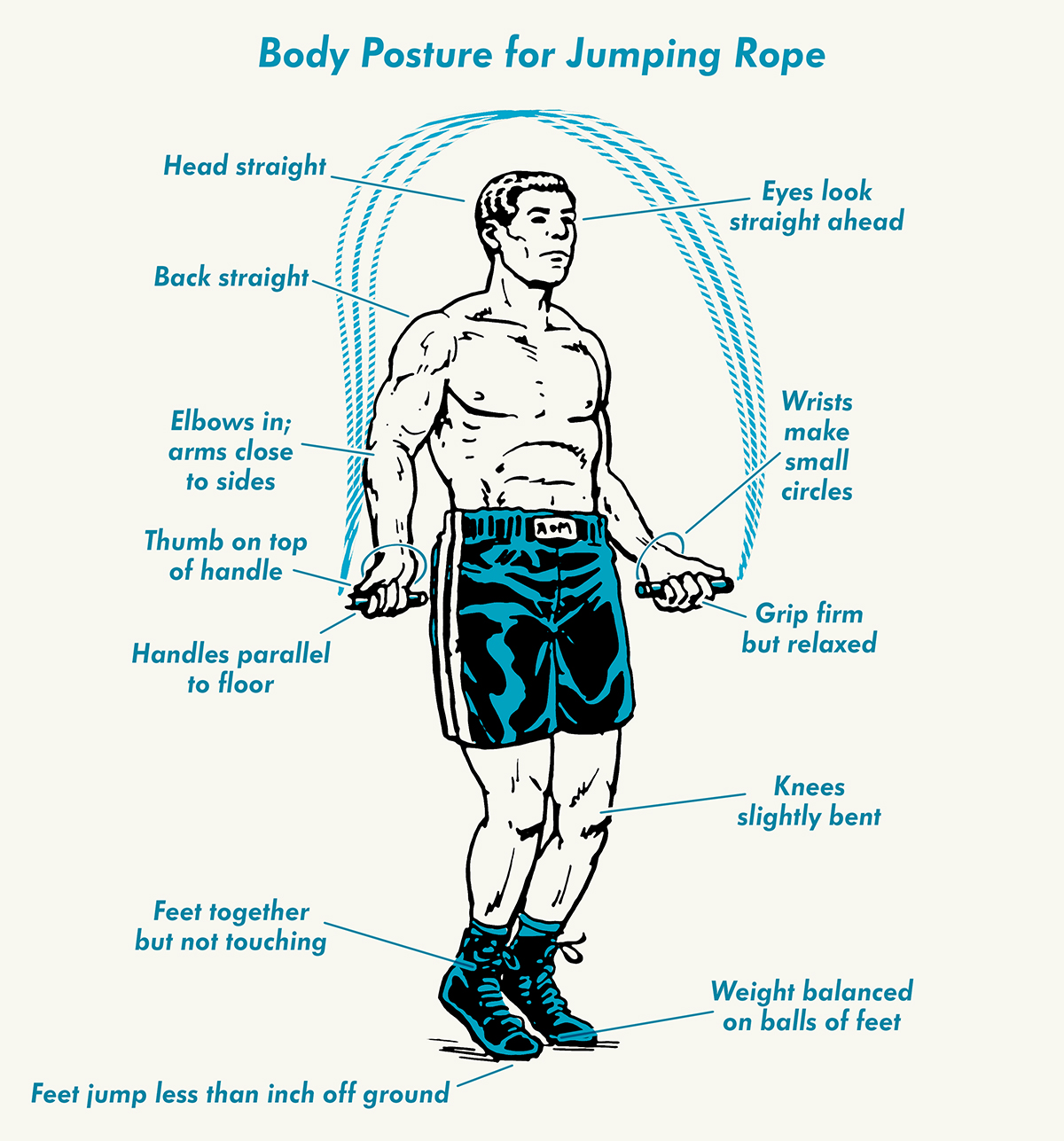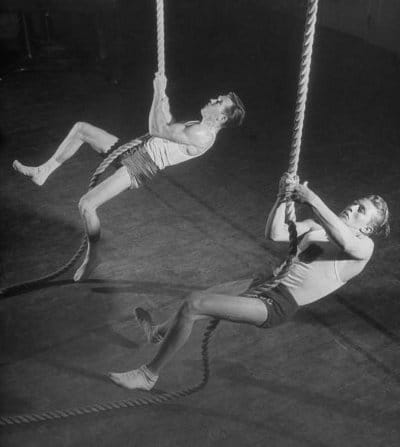With our archives now 3,500+ articles deep, we’ve decided to republish a classic piece each Sunday to help our newer readers discover some of the best, evergreen gems from the past. This article was originally published in January 2019.
When you think about boxers’ workouts — when you mentally run through all the real life preparation they put in before a fight, as well as all the cinematic training montages you can remember — one exercise probably comes most readily to mind: jumping rope.
Boxers, from bare-knuckle brawlers like John L. Sullivan to modern champs like Manny Pacquiao, have indeed made jumping rope a big part of their training regimens throughout the long history of the sweet science. And with good reason: the benefits of this exercise abound.
If you’re not planning on climbing into a ring anytime soon, you probably don’t think of jump roping very often; to get in your cardio or HIIT workouts, you’re more likely to mount some machine at the gym. Maybe that’s because you associate jumping rope with elementary school, think you’re too clumsy to do it effectively, remember it being overly monotonous, or feel like it’s too high impact an exercise for your older or heavier body.
Today we’ll show you how those objections can be overcome, and why you ought to train like a fighter by incorporating the jump rope into your workout routine.
The Benefits of Jumping Rope
Jumping rope builds your fitness, athletic skills, and even your mindset in ways few other exercises can match. When you look at the list of benefits below, it’s easy to see why boxers are particularly keen on this form of training, but these are advantages the average guy surely wants to develop as well:
- Serves as a whole body workout that incorporates all the muscle groups
- Works the body’s anaerobic and aerobic systems and efficiently burns calories
- Builds speed and quickness
- Develops overall balance, coordination, timing, and rhythm
- Intensifies power and explosiveness
- Increases reaction time and reflexes
- Gets an athlete comfortable with being in the “readiness position” — on the balls of the feet
- Enhances agility and nimbleness — lightness on the feet
- Offers practice in moving through all planes of space — up, down, backward, forward, and side-to-side
- Enhances ability to accelerate and decelerate while keeping one’s balance
- Develops body control and awareness
- Cultivates greater ability to synchronize the lower and upper body
- Increases hand-eye coordination
- Strengthens mental discipline and mindfulness (in calling upon one’s powers of concentration)
Beyond these physiological benefits, jumping rope is a super cheap and portable exercise — you can do it almost anywhere — and incredibly versatile to boot; with hundreds of variations in techniques, patterns, and progressions, it’s a workout you can keep perennially fresh.
How to Choose a Jump Rope
The first step in getting into jumping rope is to choose a rope to use. There are two big considerations in making this decision:
Type

Jack Dempsey shared his old school DIY method of making a boxer’s jump rope in his book, Championship Fighting: “you can make a rope by soaking a piece of clothesline overnight in a can of light lubricating oil. Hang up the rope and let it dry for a day. Then, fold the ends of the rope back and tape them into ‘handles’ with bicycle tape.”
There are many different types of jump ropes made from different kinds of materials. The main categories here are “speed ropes” and “heavy ropes.” Speed ropes are lightweight, made for fast turning, and, as the name implies, built for speed. Heavy ropes are weighted in the rope and/or handles, turn more slowly, and are designed to strengthen the upper body.
Your best bet is to go with a speed rope. As Olympic wrestler and conditioning coach, former Marine, and all-around rope jumping expert Buddy Lee explains: “A jump rope training program is best used for developing speed, quickness, agility, and explosiveness, and a lightweight speed rope enables you to maximize these and other benefits of jump rope training.”
As for material, you want your rope to be made out of plastic. Plastic ropes are durable and cut down on air resistance for greater speed. Cotton and leather ones drag in the air and don’t turn quickly enough, and will wear out sooner as well.
They make jump ropes these days that track your skipping data and connect to an app and all that jazz, but you don’t need those bells and whistles. When we asked Jay Deas, trainer/manager of heavyweight champ Deontay “the Bronze Bomber” Wilder and owner of Skyy Boxing Gym in Alabama for some rope jumping tips, he said: “I don’t need the weighted jump rope or the one that gives you your cholesterol or tells you about your love lines. I like a good basic jump rope.”
Length
Jump ropes come in different sizes. The right length for you depends both on your height and rope jumping ability.
A rope that’s too long is going to be less aerodynamic, and create more tangles and snags. If you hear the rope smacking the ground a lot, it’s probably too long. At the same time, you don’t want it too short, or you’ll be, as Deas puts it, “all hunched up like an old man trying to jump rope.”

To find the correct jump rope length for you, step on the middle of the rope with one foot, and then pull both handles up along the side of your body, so the rope is straight and taut.
For the beginner, the handles should reach to the shoulder. When jumping you should have about a foot of clearance between your head and the rope, and the rope should just graze the ground as it goes under your feet.
If you get more advanced with your jumping, you can shorten the rope so that it reaches your underarm or even upper chest (with 2-6 fewer inches of clearance above your head). As Lee explains, shortening the rope can enhance the benefits you get from jumping: “When you use a shorter rope, you have less room for error and are forced to move your hands and feet faster, which dramatically increases rotational speed. This process increases your whole-body awareness, helps you develop lightning-fast reflexes, and improves your reaction time.”
A rope that rises to somewhere between the shoulder and armpit will work for most people, however, and it’s better to have a jump rope that’s longer rather than shorter. You can adjust a rope that’s too long to be shorter, but you can’t make a short rope longer.
Setting Up for Success
Effective, efficient, injury-free jumping begins with how you set up to perform this exercise, both in where you choose to do your jumping, and your body’s position/posture while you do so.
Choosing a Location
A lot of guys shy away from jumping rope because they think it’s too hard on their body. But you can reduce the impact by choosing a jumping surface that offers a little more rebound (for when you take off), and absorbs a little more force (for when you land). Avoid very hard surfaces like asphalt or concrete when you can, instead choosing surfaces that have a little more give, while still being firm. This includes wood floors, firm rubberized floors or mats, artificial turf, thin carpet, short grass, and solid, level dirt.
When you choose a spot, make sure there’s enough clearance all around you, that you won’t whack an object or a person with your rope.
Body Posture

Your posture will greatly affect your jumping performance and risk for injury. Follow the guidelines above to set yourself up for effectiveness and efficiency.
A couple mistakes that jumping rookies often make are worth emphasizing:
The first mistake is using your arms too much. Deas says, “The main thing is you want to use your wrists — you don’t want your arms going in big windmill motions. You want to let your wrists do the action.”
The second mistake to avoid is jumping too high, which creates excess impact on your body; you only need to jump 1/2-3/4” off the ground — just high enough to clear the rope. Watch how little Pacquiao’s feet come off the ground as he jumps:
Different Jumps to Incorporate Into Your Routine
People frequently steer clear of jumping rope because they think it’s too monotonous. That’s probably because they only learned how to do one or two jumps, and then performed them over and over again.
In reality, there are many different jumps you can do to perennially mix up your routine and keep from getting bored. As Deas notes, jumping rope “should be something you look forward to, and that can only happen when you’re doing a lot of creative things with it. . . . that’s what’s going to keep it fun.”
The two basic jumps to first master are the Bounce Step (your basic, two-footed up and down jump) and the Alternate-Foot Step (like running in place). From there you can try out many other skills. Here are a dozen foundational ones:
- Boxer’s Skip [lower impact/lower energy way to keep jumping for longer periods of time, and gain the rhythm a boxer needs in the ring]
- Boxer’s Heel Toe Step
- High Knees
- Front Saddle
- Side Straddle
- Skier Jump
- Bell Jump
- Foot Cross
- Backward Jump
- Arm Cross Over/Criss-Cross
- Arm Side Swing
With most of these, you can turn them into what Lee calls a “Power” variation, where you do the same jump, but swing the rope two (or more) times underneath you before you land. The most famous of these kinds of jumps is the Double Under — a Bounce Step where the rope passes under your feet twice in one jump.
You can put these various jumps together into an endless number of different rhythmic progressions and sets. Mix it up, realizing that all these techniques will take time and practice to really get down. Deas says: “Don’t be scared of trying tricks — crossing the rope and double jumping . . . You’re going to mess up over and over; just keep trying fun new things. Eventually you’ll get ‘em, and once you get ‘em it’s like riding a bike.”
Boxer Workouts

John L. Sullivan would get grotesquely out of shape in-between title defenses, only to whip himself (or rather to be whipped by trainers) into condition as the fight approached. His regimen included jumping rope, which at first he found awkward, and, clocking in at 220 lbs, painful. But after being able to do few consecutive skips without tripping, he got the hang of the rhythm, would do 10 sets of 100 jumps every workout, and took pride in the way the exercise strengthened and trimmed his body.
Boxers incorporate jumping rope into their workouts in several ways.
First it’s often used as a warm-up and/or cool-down, with anywhere from 10-20 minutes of continuous, but not super strenuous, jumping (incorporating various kinds of jumps).
It can be used as straight cardio as well; e.g., 3 sets of 10 minutes of continuous jumping with 2 minutes of rest in between. Or 2 sets of 15 minutes of continuous jumping. Or when you get good, 30 or more minutes of jumping non-stop.
Jumping rope is also sometimes used to structure the high intensity portion of a workout, in a way that’s designed to mimic the high intensity demands of a real boxing match. In a pro fight, each round lasts 3 minutes, with a 1-minute rest in between. So to simulate these circumstances, Deas has his boxers do rounds like this:
- 3 minutes “very, very fast” jumping
- 1 minute slow jumping active rest
- Repeat
Do as many rounds of this as you can.
Everlast recommends a HIIT workout structured this way:
- Jump Rope (max speed): 15 sec
- Shadow Box: 15 sec
- Rest: 30 sec
The more fit you are, the more rounds of this workout you can do; pick a level from Beginner to Champion:
- Beginner Level: 4 rounds
- Contender Level: 8 rounds
- Champion Level: 12 rounds
Finally, in 101 Best Jump Rope Workouts Lee recommends this 24-minute workout for boxers (to be done after warming up):
Round 1
- Alternate Foot Step with Arm Cross Over: 3 minutes
- Speed Bag: 1 minute
- Rest: 1 minute
Round 2
- Alternate between Basic Bounce and Alternate Foot Step: 3 minutes
- Bicycle Crunches: 1 minute
- Rest: 1 minute
Round 3
- Alternate between Arm Cross Over and Side Swing to Jump: 3 minutes
- Speed Bag: 1 minute
- Rest: 1 minute
Round 4:
- Alternate between High Step with Arm Cross Over and Double Unders (Arm Cross Over): 3 minutes
- Leg Raises: 1 minute
- Rest: 1 minute
Round 5:
- Alternate between Forward Shuffle and Backward Shuffle: 3 minutes
- Speed Bag: 1 minute
- Rest: 1 minute
Round 6:
- Alternate between Backwards Jumping and Alternate Foot step: 3 minutes
- Russian Twist: 1 minute
Deas recommends incorporating jump rope training into your workouts 3X a week, starting out with just once or twice if you’re a beginner. Work your way into jumping rope slowly, with 5-10 minutes a few times a week, so you don’t injure yourself as you build up stamina and practice technique. Pretty soon you’ll be skipping rope like a fighter and be able to go the distance.
_______________________________________
Thanks to Jay Deas for the advice.
Additional Resources:
101 Best Jump Rope Workouts by Buddy Lee
Jump Rope Training by Buddy Lee
Tags: Exercises







